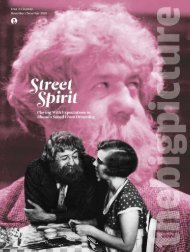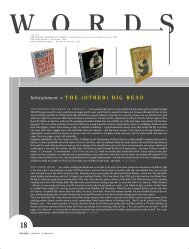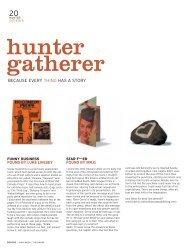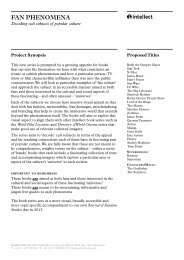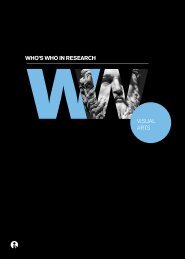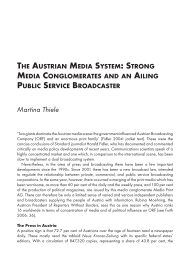Anthem - Intellect
Anthem - Intellect
Anthem - Intellect
You also want an ePaper? Increase the reach of your titles
YUMPU automatically turns print PDFs into web optimized ePapers that Google loves.
<strong>Anthem</strong><br />
normally need to be made orally in order to fully convince of their authenticity and<br />
sincerity, and music is a way of organising such expressions in a more direct way than<br />
in the linguistic system built on words. Susanne K. Langer thus characterised music<br />
as a presentational symbolism, which is experienced in a holistic way, in contrast to<br />
the discursive one of verbal language, where clearly distinct elements are added in<br />
a sequence. 335 Psychoanalytical theorists have similarly linked music to pre-verbal<br />
psychic strata, as hearing is developed earlier in the infant than seeing, and thus has<br />
mental roots that go back to before language acquisition, to more archaic strata that<br />
are closely linked to deep-seated bodily and pre-rational emotions. Such specificities<br />
have led some semioticians and cultural theorists to argue that music is a form of<br />
communication without meaning. 336<br />
This whole line of thought has been brought under critical scrutiny by theorists<br />
like Jacques Derrida, who questions the linear developmental logic and essentialist<br />
romanticisation behind the idea that sound and voice are more primordial than sight<br />
and vision. 337 I see no reason to believe that musical sounds are any less meaningful<br />
than words—only the precise signifying procedures differ. 338 The particular kind of<br />
bodily activity involved in the use of voice and ear in making or listening to music do<br />
not prevent them from communicating meanings, but may at least partially explain why<br />
music is so often experienced as a vague and emotional mode of expression. Whether<br />
art music or popular music, with or without words, foregrounded or for instance in<br />
film soundtracks—music certainly is able to invoke meanings that are determined by<br />
interpretive communities of listeners and music makers, in geographically and socially<br />
situated communities that evolve historically, but it never escapes the cumulated networks<br />
of signification that constitute the traditions of musical genres. Parallel to verbal and<br />
visual modes of communication, pieces of music mean something to people in shifting<br />
contexts, and these meanings are polysemic and negotiable, inserted in the never-ending<br />
stream of conflicts of interpretation that is extended by every new usage and discourse.<br />
While eyes may deliberately be directed and closed, this is not as easily done with<br />
ears. Music therefore has an almost intrusive material force on human bodies, and<br />
can be perceived even when people strive to focus on something else. Music is hard<br />
to block out but at the same time often out of focus, serving as a background to other<br />
activities. These qualities also make it difficult to focus on discursively, and most<br />
people find it much harder to find words to clearly describe music than images.<br />
Music is itself a multimodal form of expression, as a full musical experience does<br />
not only emanate from abstracted sounds but also involves sight and other human<br />
senses. Music is further easily combined with other modes, not least verbal and visual<br />
ones. Music also often exists in combination with lyrics in song and with gestural<br />
or cinematic visuality in opera or film. Besides such multimodal genres and art<br />
forms, many people enjoy reading, writing or working with something silent while<br />
simultaneously listening to music in the background that boosts their energy or<br />
151



